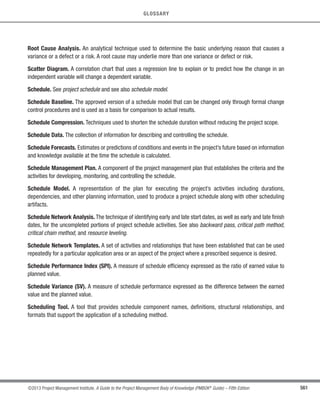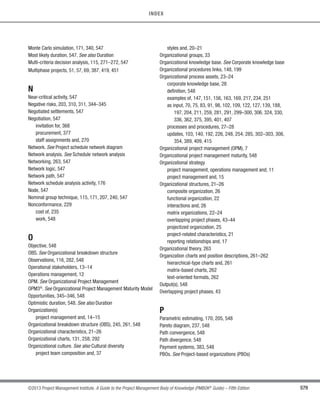The document is the fifth edition of A Guide to the Project Management Body of Knowledge (PMBOK® Guide) published by the Project Management Institute. It provides guidance and standards for project management practices. The guide outlines 10 knowledge areas and 5 process groups that are generally recognized as good practices for managing most projects most of the time. It is intended to be a foundation for the development of tailored project management methodologies and processes.

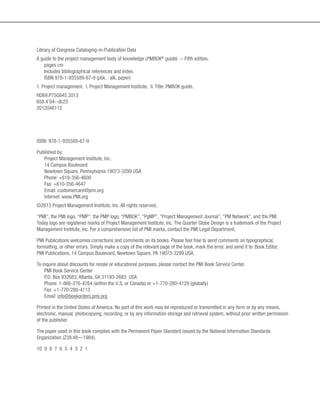

























![2 ©2013 Project Management Institute. A Guide to the Project Management Body of Knowledge (PMBOK®
Guide) – Fifth Edition
1 - INTRODUCTION
1.1 Purpose of the PMBOK®
Guide
The acceptance of project management as a profession indicates that the application of knowledge, processes,
skills, tools, and techniques can have a significant impact on project success. The PMBOK®
Guide identifies that
subset of the project management body of knowledge that is generally recognized as good practice. “Generally
recognized” means the knowledge and practices described are applicable to most projects most of the time, and
there is consensus about their value and usefulness. “Good practice” means there is general agreement that the
application of the knowledge, skills, tools, and techniques can enhance the chances of success over many projects.
“Good practice” does not mean that the knowledge described should always be applied uniformly to all projects; the
organization and/or project management team is responsible for determining what is appropriate for any given project.
The PMBOK®
Guide also provides and promotes a common vocabulary within the project management
profession for using and applying project management concepts. A common vocabulary is an essential element of
a professional discipline.The PMI Lexicon of Project Management Terms [1]1
provides the foundational professional
vocabulary that can be consistently used by project, program, and portfolio managers and other stakeholders.
Annex A1 is a foundational reference for PMI’s project management professional development programs. Annex
A1 continues to evolve along with the profession, and is therefore not all-inclusive; this standard is a guide rather
than a specific methodology. One can use different methodologies and tools (e.g., agile, waterfall, PRINCE2) to
implement the project management framework.
In addition to the standards that establish guidelines for project management processes,the Project Management
Institute Code of Ethics and Professional Conduct [2] guides practitioners of the profession and describes the
expectations that practitioners should hold for themselves and others. The Project Management Institute Code
of Ethics and Professional Conduct is specific about the basic obligation of responsibility, respect, fairness, and
honesty. It requires that practitioners demonstrate a commitment to ethical and professional conduct. It carries
the obligation to comply with laws, regulations, and organizational and professional policies. Practitioners come
from diverse backgrounds and cultures, and the Project Management Institute Code of Ethics and Professional
Conduct applies globally. When interacting with any stakeholder, practitioners should be committed to honest,
responsible, fair practices and respectful dealings.Acceptance of the code is essential for project managers, and is
a requirement for the following PMI®
exams:
• Certified Associate in Project Management (CAPM)®
• Project Management Professional (PMP)®
• Program Management Professional (PgMP)®
• PMI Agile Certified Practitioner (PMI-ACP)SM
• PMI Risk Management Professional (PMI-RMP)®
• PMI Scheduling Professional (PMI-SP)®
1
The numbers in brackets refer to the list of references at the end of this standard.
Licensed To: Jorge Diego Fuentes Sanchez PMI MemberID: 2399412
This copy is a PMI Member benefit, not for distribution, sale, or reproduction.](https://image.slidesharecdn.com/pmbokguide5thed-230706034623-8dd99ae7/85/PMBOKGuide_5th_Ed-pdf-28-320.jpg)
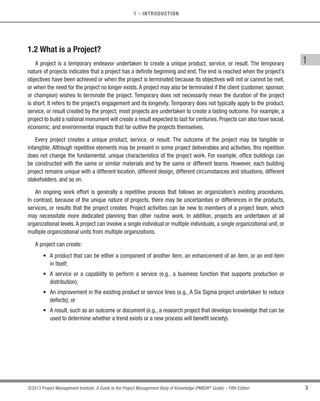


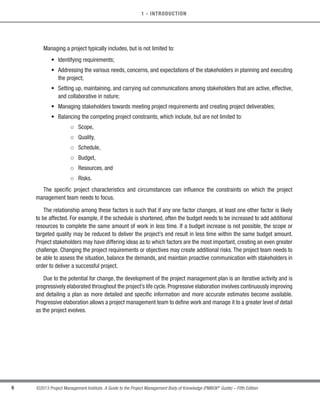


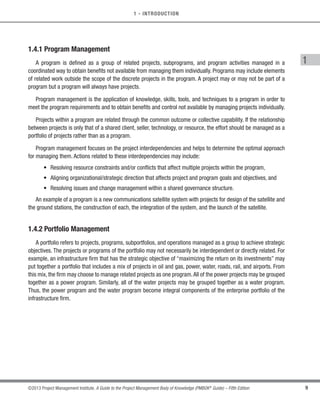








![18 ©2013 Project Management Institute. A Guide to the Project Management Body of Knowledge (PMBOK®
Guide) – Fifth Edition
1 - INTRODUCTION
• Leadership,
• Team building,
• Motivation,
• Communication,
• Influencing,
• Decision making,
• Political and cultural awareness,
• Negotiation,
• Trust building,
• Conflict management, and
• Coaching.
1.8 Project Management Body of Knowledge
The PMBOK®
Guide contains the standard for managing most projects most of the time across many types of
industries. The standard, included in Annex A1, describes the project management processes used to manage a
project toward a more successful outcome.
This standard is unique to the project management field and has interrelationships to other project management
disciplines such as program management and portfolio management.
Project management standards do not address all details of every topic. This standard is limited to individual
projects and the project management processes that are generally recognized as good practice. Other standards
may be consulted for additional information on the broader context in which projects are accomplished, such as:
• The Standard for Program Management [3] addresses the management of programs,
• The Standard for Portfolio Management [4] addresses the management of portfolios,
•
Organizational Project Management Maturity Model (OPM3®
) [5] examines an enterprise’s project
management process capabilities.
Licensed To: Jorge Diego Fuentes Sanchez PMI MemberID: 2399412
This copy is a PMI Member benefit, not for distribution, sale, or reproduction.](https://image.slidesharecdn.com/pmbokguide5thed-230706034623-8dd99ae7/85/PMBOKGuide_5th_Ed-pdf-44-320.jpg)


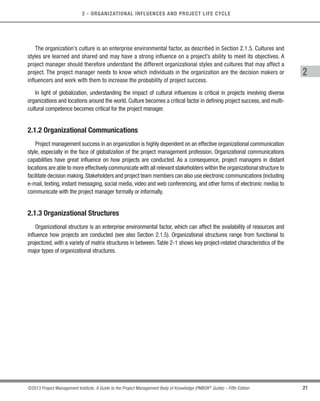




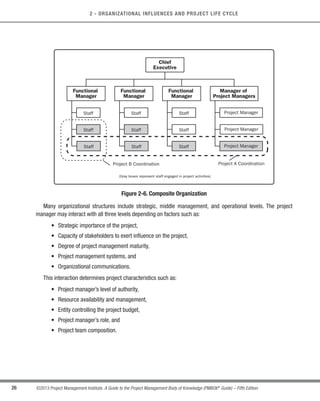


















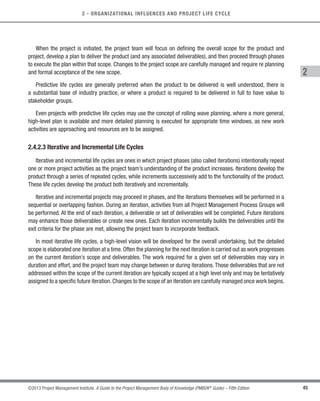



















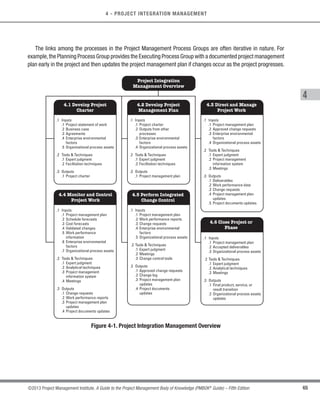



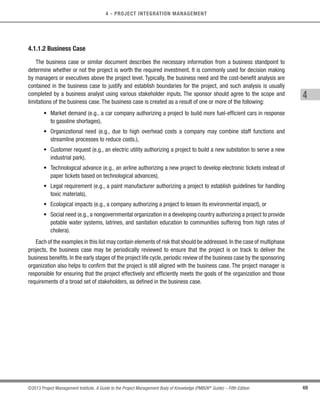
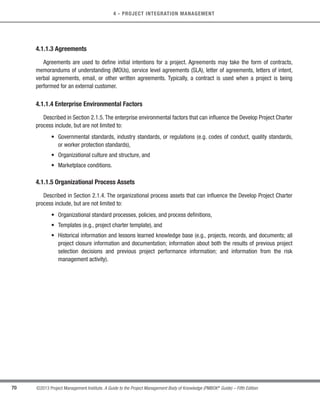
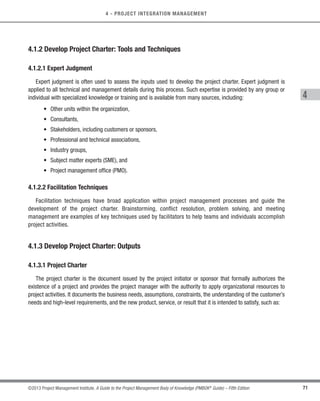



























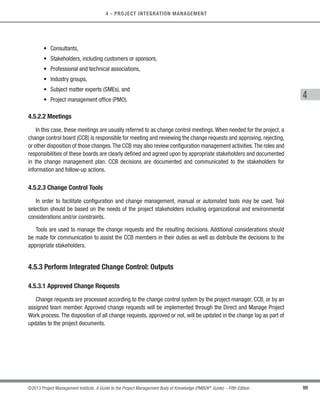




















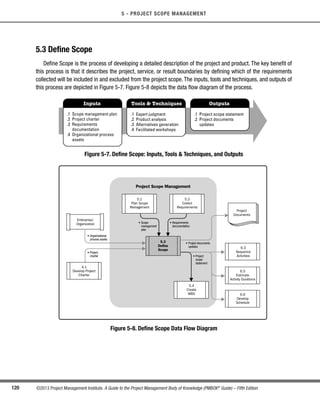






![127
©2013 Project Management Institute. A Guide to the Project Management Body of Knowledge (PMBOK®
Guide) – Fifth Edition
5 - PROJECT SCOPE MANAGEMENT
5
5.4.1 Create WBS: Inputs
5.4.1.1 Scope Management Plan
Described in Section 5.1.3.1. The scope management plan specifies how to create the WBS from the detailed
project scope statement and how the WBS will be maintained and approved.
5.4.1.2 Project Scope Statement
Described in Section 5.3.3.1. The project scope statement describes the work that will be performed and the
work that is excluded. It also lists and describes the specific internal or external restrictions or limitations that may
affect the execution of the project.
5.4.1.3 Requirements Documentation
Described in Section 5.2.3.1. Detailed requirements documentation is essential for understanding what needs
to be produced as the result of the project and what needs to be done to deliver the project and its final products.
5.4.1.4 Enterprise Environmental Factors
Described in Section 2.1.5. Industry-specific WBS standards, relevant to the nature of the project, may serve
as external reference sources for creation of the WBS. For example, engineering projects may reference ISO/IEC
15288 on Systems Engineering – System Life Cycle Processes [6], to create a WBS for a new project.
5.4.1.5 Organizational Process Assets
Described in Section 2.1.4. The organizational process assets that can influence the Create WBS process
include, but are not limited to:
• Policies, procedures, and templates for the WBS;
• Project files from previous projects; and
• Lessons learned from previous projects.
Licensed To: Jorge Diego Fuentes Sanchez PMI MemberID: 2399412
This copy is a PMI Member benefit, not for distribution, sale, or reproduction.](https://image.slidesharecdn.com/pmbokguide5thed-230706034623-8dd99ae7/85/PMBOKGuide_5th_Ed-pdf-153-320.jpg)



![131
©2013 Project Management Institute. A Guide to the Project Management Body of Knowledge (PMBOK®
Guide) – Fifth Edition
5 - PROJECT SCOPE MANAGEMENT
5
Decomposition of the upper-level WBS components requires subdividing the work for each of the deliverables
or subcomponents into its most fundamental elements, where the WBS components represent verifiable products,
services,or results.TheWBS may be structured as an outline,an organizational chart,or other method that identifies
a hierarchical breakdown.Verifying the correctness of the decomposition requires determining that the lower-level
WBS components are those that are necessary and sufficient for completion of the corresponding higher-level
deliverables. Different deliverables can have different levels of decomposition. To arrive at a work package, the
work for some deliverables needs to be decomposed only to the next level, while others need additional levels of
decomposition. As the work is decomposed to greater levels of detail, the ability to plan, manage, and control the
work is enhanced. However, excessive decomposition can lead to nonproductive management effort, inefficient
use of resources, decreased efficiency in performing the work, and difficulty aggregating data over different levels
of the WBS.
Decomposition may not be possible for a deliverable or subcomponent that will be accomplished far into the
future. The project management team usually waits until the deliverable or subcomponent is agreed on, so the
details of the WBS can be developed. This technique is sometimes referred to as rolling wave planning.
The WBS represents all product and project work, including the project management work.The total of the work
at the lowest levels should roll up to the higher levels so that nothing is left out and no extra work is performed.
This is sometimes called the 100 percent rule.
For specific information regarding the WBS, refer to the Practice Standard for Work Breakdown Structures –
Second Edition [7]. This standard contains industry-specific examples of WBS templates that can be tailored to
specific projects in a particular application area.
5.4.3 Create WBS: Outputs
5.4.3.1 Scope Baseline
The scope baseline is the approved version of a scope statement, work breakdown structure (WBS), and its
associated WBS dictionary, that can be changed only through formal change control procedures and is used as a
basis for comparison. It is a component of the project management plan. Components of the scope baseline include:
•
Project scope statement. The project scope statement includes the description of the project scope,
major deliverables, assumptions, and constraints.
Licensed To: Jorge Diego Fuentes Sanchez PMI MemberID: 2399412
This copy is a PMI Member benefit, not for distribution, sale, or reproduction.](https://image.slidesharecdn.com/pmbokguide5thed-230706034623-8dd99ae7/85/PMBOKGuide_5th_Ed-pdf-157-320.jpg)










![142 ©2013 Project Management Institute. A Guide to the Project Management Body of Knowledge (PMBOK®
Guide) – Fifth Edition
6 - PROJECT TIME MANAGEMENT
These processes interact with each other and with processes in other Knowledge Areas as described in detail
in Section 3 and Annex A1.
Distinguishing the project schedule presentation (schedule) from the schedule data (Section 6.6.3.3) and
calculations that produce the project schedule (Section 6.6.3.2) is practiced by referring to the scheduling tool
populated with project data as the schedule model. A schedule model is a representation of the plan for executing
the project’s activities including durations, dependencies, and other planning information, used to produce project
schedules along with other scheduling artifacts. For specific information regarding the schedule model, refer to the
Practice Standard for Scheduling. [8]
On some projects, especially those of smaller scope, defining activities, sequencing activities, estimating
activity resources, estimating activity durations, and developing the schedule model are so tightly linked that they
are viewed as a single process that can be performed by a person over a relatively short period of time. These
processes are presented here as distinct elements because the tools and techniques for each process are different.
The Project Time Management processes and their associated tools and techniques are documented in the
schedule management plan.The schedule management plan is a subsidiary plan of, and integrated with, the project
management plan through the Develop Project Management Plan process (Section 4.2),The schedule management
plan identifies a scheduling method and scheduling tool (Figure 6-2), and sets the format and establishes criteria
for developing and controlling the project schedule. The selected scheduling method defines the framework and
algorithms used in the scheduling tool to create the schedule model. Some of the better known scheduling methods
include critical path method (CPM) and critical chain method (CCM).
Project schedule development uses the outputs from the processes to define activities, sequence activities,
estimate activity resources, and estimate activity durations in combination with the scheduling tool to produce
the schedule model. The finalized and approved schedule is the baseline that will be used in the Control Schedule
process (Section 6.7). As the project activities are being performed, the majority of effort in the Project Time
Management Knowledge Area will occur in the Control Schedule process to ensure completion of project work in a
timely manner. Figure 6-2 provides a scheduling overview that shows how the scheduling method, scheduling tool,
and outputs from the Project Time Management processes interact to create a project schedule.
Licensed To: Jorge Diego Fuentes Sanchez PMI MemberID: 2399412
This copy is a PMI Member benefit, not for distribution, sale, or reproduction.](https://image.slidesharecdn.com/pmbokguide5thed-230706034623-8dd99ae7/85/PMBOKGuide_5th_Ed-pdf-168-320.jpg)






![149
©2013 Project Management Institute. A Guide to the Project Management Body of Knowledge (PMBOK®
Guide) – Fifth Edition
6 - PROJECT TIME MANAGEMENT
6
•
Rules of performance measurement. Earned value management (EVM) rules or other physical
measurement rules of performance measurement are set. For example, the schedule management plan
may specify:
○
○ Rules for establishing percent complete,
○
○ Control accounts at which management of progress and schedule will be measured,
○
○
Earned value measurement techniques (e.g., baselines, fixed-formula, percent complete, etc.)
to be employed (for more specific information, refer to the Practice Standard for Earned Value
Management) [9],
○
○ Schedule performance measurements such as schedule variance (SV) and schedule performance
index (SPI) used to assess the magnitude of variation to the original schedule baseline.
• Reporting formats. The formats and frequency for the various schedule reports are defined.
• Process descriptions. Descriptions of each of the schedule management processes are documented.
6.2 Define Activities
Define Activities is the process of identifying and documenting the specific actions to be performed to produce
the project deliverables.The key benefit of this process is to break down work packages into activities that provide
a basis for estimating, scheduling, executing, monitoring, and controlling the project work. The inputs, tools and
techniques, and outputs of this process are depicted in Figure 6-5. Figure 6-6 depicts the data flow diagram of the
process.
Inputs Tools Techniques Outputs
.1 Schedule management
plan
.2 Scope baseline
.3 Enterprise environmental
factors
.4 Organizational process
assets
.1 Decomposition
.2 Rolling wave planning
.3 Expert judgment
.1 Activity list
.2 Activity attributes
.3 Milestone list
Figure 6-5. Define Activities: Inputs, Tools Techniques, and Outputs
Licensed To: Jorge Diego Fuentes Sanchez PMI MemberID: 2399412
This copy is a PMI Member benefit, not for distribution, sale, or reproduction.](https://image.slidesharecdn.com/pmbokguide5thed-230706034623-8dd99ae7/85/PMBOKGuide_5th_Ed-pdf-175-320.jpg)




































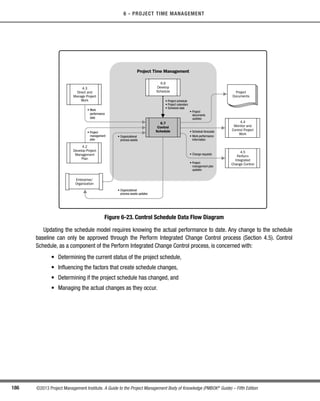

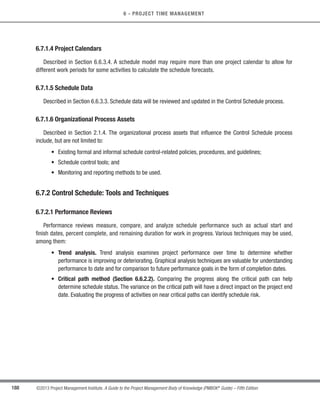
































![221
©2013 Project Management Institute. A Guide to the Project Management Body of Knowledge (PMBOK®
Guide) – Fifth Edition
7 - PROJECT COST MANAGEMENT
7
•
EAC forecast for ETC work considering both SPI and CPI factors. In this forecast, the ETC work will
be performed at an efficiency rate that considers both the cost and schedule performance indices. This
method is most useful when the project schedule is a factor impacting the ETC effort. Variations of this
method weight the CPI and SPI at different values (e.g., 80/20, 50/50, or some other ratio) according to
the project manager’s judgment. Equation: EAC = AC + [(BAC – EV) / (CPI × SPI)]
Each of these approaches is applicable for any given project and will provide the project management team with
an “early warning” signal if the EAC forecasts are not within acceptable tolerances.
7.4.2.3 To-Complete Performance Index (TCPI)
The to-complete performance index (TCPI) is a measure of the cost performance that is required to be achieved
with the remaining resources in order to meet a specified management goal, expressed as the ratio of the cost to
finish the outstanding work to the remaining budget.TCPI is the calculated cost performance index that is achieved
on the remaining work to meet a specified management goal, such as the BAC or the EAC. If it becomes obvious
that the BAC is no longer viable, the project manager should consider the forecasted EAC. Once approved, the EAC
may replace the BAC in the TCPI calculation. The equation for the TCPI based on the BAC: (BAC – EV) / (BAC – AC).
The TCPI is conceptually displayed in Figure 7-13. The equation for the TCPI is shown in the lower left as the
work remaining (defined as the BAC minus the EV) divided by the funds remaining (which can be either the BAC
minus the AC, or the EAC minus the AC).
If the cumulative CPI falls below the baseline (as shown in Figure 7-13), all future work of the project will need
to be performed immediately in the range of the TCPI (BAC) (as reflected in the top line of Figure 7-13) to stay
within the authorized BAC. Whether this level of performance is achievable is a judgment call based on a number
of considerations, including risk, schedule, and technical performance. This level of performance is displayed as
the TCPI (EAC) line. The equation for the TCPI based on the EAC: (BAC – EV) / (EAC – AC). The EVM formulas are
provided in Table 7-1.
Licensed To: Jorge Diego Fuentes Sanchez PMI MemberID: 2399412
This copy is a PMI Member benefit, not for distribution, sale, or reproduction.](https://image.slidesharecdn.com/pmbokguide5thed-230706034623-8dd99ae7/85/PMBOKGuide_5th_Ed-pdf-247-320.jpg)


![224 ©2013 Project Management Institute. A Guide to the Project Management Body of Knowledge (PMBOK®
Guide) – Fifth Edition
7 - PROJECT COST MANAGEMENT
Table 7-1. Earned Value Calculations Summary Table
Earned Value Analysis
Lexicon Definition How Used Equation
Abbreviation Name Interpretation of Result
The authorized budget assigned to
scheduled work.
The measure of work performed
expressed in terms of the budget
authorized for that work.
The realized cost incurred for the
work performed on an activity during
a specific time period.
The sum of all budgets established
for the work to be performed.
The amount of budget deficit or
surplus at a given point in time,
expressed as the difference between
the earned value and the actual cost.
The amount by which the project is
ahead or behind the planned
delivery date, at a given point in
time, expressed as the difference
between the earned value and the
planned value.
A projection of the amount of budget
deficit or surplus, expressed as the
difference between the budget at
completion and the estimate at
completion.
A measure of the cost efficiency of
budgeted resources
expressed as the ratio of earned
value to actual cost.
A measure of schedule efficiency
expressed as the ratio of earned
value to planned value.
The expected total cost of com-
pleting all work expressed as the
sum of the actual cost to date and
the estimate to complete.
The expected cost to finish all the
remaining project work.
A measure of the cost performance
that must be achieved with the
remaining resources in order to meet
a specified management goal,
expressed as the ratio of the cost to
finish the outstanding work to the
budget available.
Planned
Value
Earned Value
Actual Cost
Budget at
Completion
Cost Variance
Schedule
Variance
Variance at
Completion
Cost
Performance
Index
Schedule
Performance
Index
Estimate At
Completion
Estimate to
Complete
To Complete
Performance
Index
PV
EV
AC
BAC
CV
SV
VAC
CPI
SPI
EAC
ETC
TCPI
The value of the work planned to be
completed to a point in time, usually
the data date, or project completion.
The planned value of all the work
completed (earned) to a point in
time, usually the data date, without
reference to actual costs.
The actual cost of all the work
completed to a point in time, usually
the data date.
The value of total planned work, the
project cost baseline.
The difference between the value of
work completed to a point in time,
usually the data date, and the actual
costs to the same point in time.
The difference between the work
completed to a point in time, usually
the data date, and the work planned
to be completed to the same point
in time.
The estimated difference in cost at
the completion of the project.
A CPI of 1.0 means the project is
exactly on budget, that the work
actually done so far is exactly the
same as the cost so far. Other values
show the percentage of how much
costs are over or under the budgeted
amount for work accomplished.
An SPI of 1.0 means that the project
is exactly on schedule, that the work
actually done so far is exactly the
same as the work planned to be
done so far. Other values show the
percentage of how much costs are
over or under the budgeted amount
for work planned.
If the CPI is expected to be the same
for the remainder of the project, EAC
can be calculated using:
If future work will be accomplished
at the planned rate, use:
If the initial plan is no longer valid,
use:
If both the CPI and SPI influence the
remaining work, use:
Assuming work is proceeding on
plan, the cost of completing the
remaining authorized work can be
calculated using:
Reestimate the remaining work from
the bottom up.
The efficiency that must be
maintained in order to complete on
plan.
The efficiency that must be
maintained in order to complete the
current EAC.
EV = sum of the planned
value of completed work
CV = EV – AC
SV = EV – PV
VAC = BAC – EAC
CPI = EV/AC
SPI = EV/PV
EAC = BAC/CPI
EAC = AC + BAC – EV
EAC = AC + Bottom-up ETC
EAC = AC + [(BAC – EV)/
(CPI x SPI)]
ETC = EAC – AC
ETC = Reestimate
TCPI = (BAC–EV)/(BAC –AC)
TCPI = (BAC – EV)/(EAC –AC)
Positive = Under planned cost
Neutral = On planned cost
Negative = Over planned cost
Positive = Ahead of Schedule
Neutral = On schedule
Negative = Behind Schedule
Positive = Under planned cost
Neutral = On planned cost
Negative = Over planned cost
Greater than 1.0 = Under planned
cost
Exactly 1.0 = On planned cost
Less than 1.0 = Over planned cost
Greater than 1.0 = Ahead of
schedule
Exactly 1.0 = On schedule
Less than 1.0 = Behind schedule
Greater than 1.0 = Harder to
complete
Exactly 1.0 = Same to complete
Less than 1.0 = Easier to complete
Greater than 1.0 = Harder to
complete
Exactly 1.0 = Same to complete
Less than 1.0 = Easier to complete
Licensed To: Jorge Diego Fuentes Sanchez PMI MemberID: 2399412
This copy is a PMI Member benefit, not for distribution, sale, or reproduction.](https://image.slidesharecdn.com/pmbokguide5thed-230706034623-8dd99ae7/85/PMBOKGuide_5th_Ed-pdf-250-320.jpg)



![228 ©2013 Project Management Institute. A Guide to the Project Management Body of Knowledge (PMBOK®
Guide) – Fifth Edition
8 - PROJECT QUALITY MANAGEMENT
•
Meeting customer requirements by overworking the project team may result in decreased profits and
increased project risks, employee attrition, errors, or rework.
•
Meeting project schedule objectives by rushing planned quality inspections may result in undetected
errors, decreased profits, and increased post-implementation risks.
Quality and grade are not the same concepts.Quality as a delivered performance or result is“the degree to which
a set of inherent characteristics fulfill requirements”(ISO 9000) [10].Grade as a design intent is a category assigned
to deliverables having the same functional use but different technical characteristics. The project manager and the
project management team are responsible for managing the tradeoffs associated with delivering the required levels
of both quality and grade. While a quality level that fails to meet quality requirements is always a problem, a low
grade of quality may not be a problem. For example:
•
It may not be a problem if a suitable low-grade software product (one with a limited number of features)
is of high quality (no obvious defects, readable manual). In this example, the product would be appropriate
for its general purpose of use.
•
It may be a problem if a high-grade software product (one with numerous features) is of low quality
(many defects, poorly organized user documentation). In essence, its high-grade feature set would prove
ineffective and/or inefficient due to its low quality.
The project management team should determine the appropriate levels of accuracy and precision for use in the
quality management plan. Precision is a measure of exactness. For example, the magnitude for each increment
on the measurement’s number line is the interval that determines the measurement’s precision—the greater the
number of increments, the greater the precision. Accuracy is an assessment of correctness. For example, if the
measured value of an item is very close to the true value of the characteristic being measured, the measurement
is more accurate. An illustration of this concept is the comparison of archery targets. Arrows clustered tightly
in one area of the target, even if they are not clustered in the bull’s-eye, are considered to have high precision.
Targets where the arrows are more spread out but equidistant from the bull’s-eye are considered to have the same
degree of accuracy. Targets where the arrows are both tightly grouped and within the bull’s-eye are considered to
be both accurate and precise. Precise measurements are not necessarily accurate measurements, and accurate
measurements are not necessarily precise measurements.
The basic approach to project quality management as described in this section is intended to be compatible
with International Organization for Standardization (ISO) quality standards. Every project should have a quality
management plan. Project teams should follow the quality management plan and should have data to demonstrate
compliance with the plan.
Licensed To: Jorge Diego Fuentes Sanchez PMI MemberID: 2399412
This copy is a PMI Member benefit, not for distribution, sale, or reproduction.](https://image.slidesharecdn.com/pmbokguide5thed-230706034623-8dd99ae7/85/PMBOKGuide_5th_Ed-pdf-254-320.jpg)








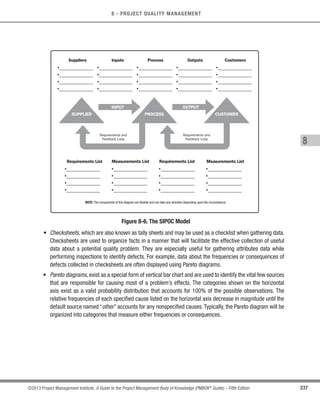



































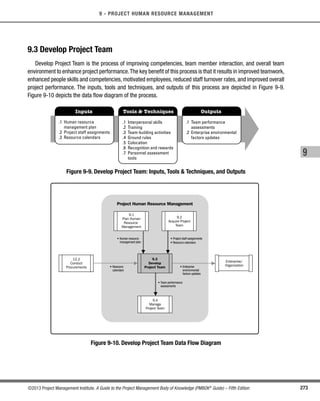




















































































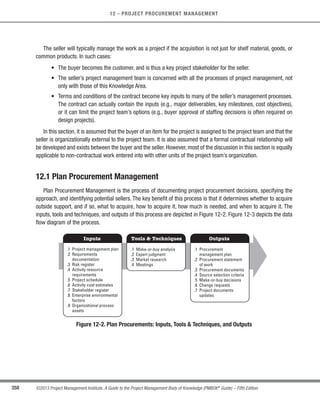



































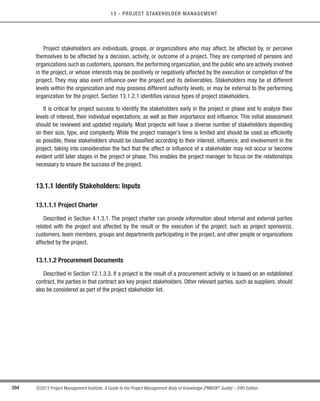












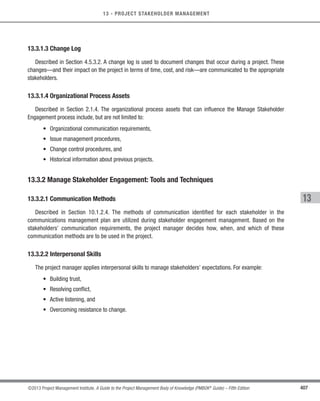










![418 ©2013 Project Management Institute. A Guide to the Project Management Body of Knowledge (PMBOK®
Guide) – Fifth Edition
ANNEX A1 - THE STANDARD FOR PROJECT MANAGEMENT OF A PROJECT
A1.1 What is a Standard?
The International Organization for Standardization (ISO) and others define a standard as a “Document approved
by a recognized body, that provides, for common and repeated use, rules, guidelines, or characteristics for products,
processes or services with which compliance are not mandatory.” (ISO 9453) [11]
In October 1998, PMI was accredited as a standards developer by the American National Standards Institute
(ANSI). The processes outlined in this Annex, which are described in the PMBOK®
Guide – Fifth Edition, provide the
standard for project management of a project.
A1.2 Framework for this Standard
This standard describes the nature of project management processes in terms of the integration between the
processes, their interactions, and the purposes they serve. For this standard, it is assumed that the project, the
project manager and the project team are assigned to the performing organization. Project management processes
are grouped into five categories known as Project Management Process Groups (or Process Groups):
•
Initiating Process Group. Those processes performed to define a new project or a new phase of an
existing project by obtaining authorization to start the project or phase.
•
Planning Process Group. Those processes required to establish the scope of the project, refine the
objectives,and define the course of action required to attain the objectives that the project was undertaken
to achieve.
•
Executing Process Group. Those processes performed to complete the work defined in the project
management plan to satisfy the project specifications.
• Monitoring and Controlling Process Group. Those processes required to track, review, and regulate the
progress and performance of the project; identify any areas in which changes to the plan are required;
and initiate the corresponding changes.
• Closing Process Group. Those processes performed to finalize all activities across all Process Groups to
formally close the project or phase.
Licensed To: Jorge Diego Fuentes Sanchez PMI MemberID: 2399412
This copy is a PMI Member benefit, not for distribution, sale, or reproduction.](https://image.slidesharecdn.com/pmbokguide5thed-230706034623-8dd99ae7/85/PMBOKGuide_5th_Ed-pdf-444-320.jpg)
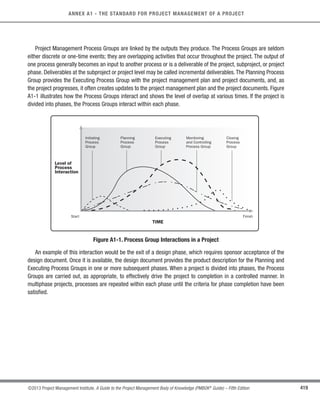























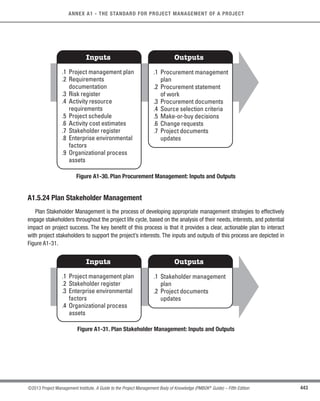









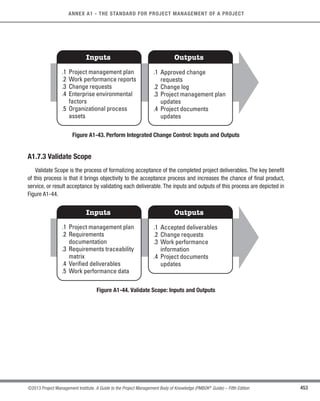



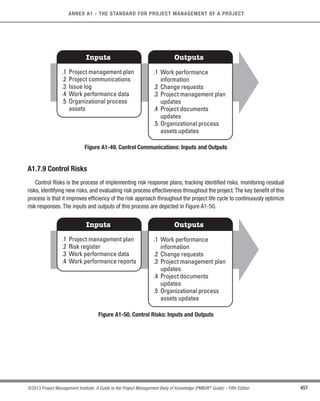





![463
©2013 Project Management Institute. A Guide to the Project Management Body of Knowledge (PMBOK®
Guide) – Fifth Edition
APPENDIX X1 - FIFTH EDITION CHANGES
APPENDIX X1
FIFTH EDITION CHANGES
The purpose of this appendix is to give a detailed explanation of the changes made to A Guide to the Project
Management Body of Knowledge (PMBOK®
Guide)—Fourth Edition to create the PMBOK®
Guide—Fifth Edition.
X1.1 Scope of Update
The approved scope for the PMBOK®
Guide – Fifth Edition explicitly states:
•
Comments and feedback, both deferred during the development of the PMBOK®
Guide – Fourth Edition
and received by PMI since its development, will be reviewed and determined whether material will be
included or excluded in the new edition.
•
Review all text and graphics in the document to make sure the information is accurate, clear, complete
and relevant, revising as necessary.
• Review,interpret,and ensure appropriate alignment with ISO 21500 [12] in the development of the standard.
• Ensure harmonization with any other relevant PMI standards.
• Consider project management role delineation study results, as appropriate.
•
Reposition Section 3 (The Standard for Project Management) as a stand-alone, ANSI-approved standard
included within the Fifth Edition as an Appendix or attachment.
•
Standard is written for project management practitioners and other stakeholders of the project
management profession.
• Standard describes the principles and processes that shape the practices that are unique to projects.
•
Standard ensures that any terminology contained within the PMI Lexicon is represented consistently and
identically in the standard.
With that directive in mind, the update team adopted an approach aimed at achieving a greater degree of
consistencyandclaritybyrefiningtheprocesses,standardizinginputsandoutputswherepossible,andimplementing
a global approach for documenting the inputs and outputs.
Licensed To: Jorge Diego Fuentes Sanchez PMI MemberID: 2399412
This copy is a PMI Member benefit, not for distribution, sale, or reproduction.](https://image.slidesharecdn.com/pmbokguide5thed-230706034623-8dd99ae7/85/PMBOKGuide_5th_Ed-pdf-489-320.jpg)

































































































